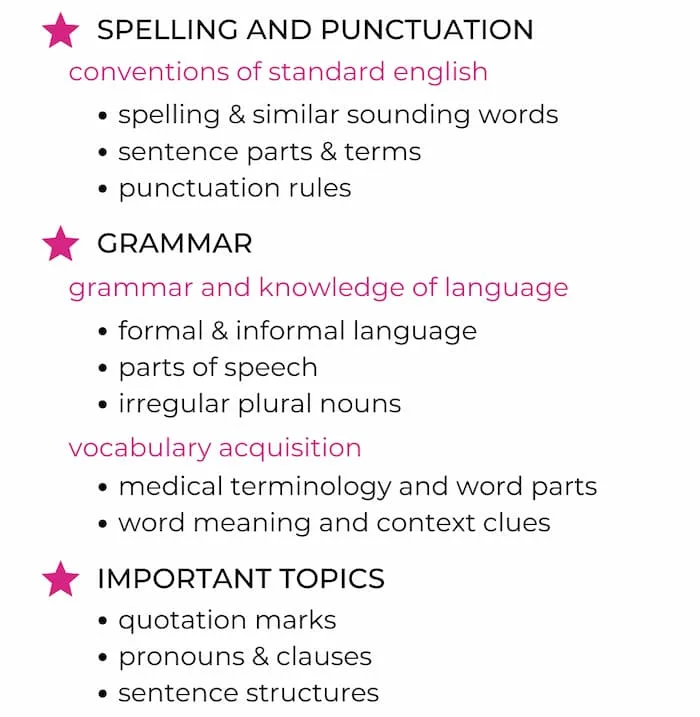Introduction
The TEAS test English language usage section assesses the student’s punctuation, grammar, sentence structure, and spelling proficiency.
It examines the aspirant’s ability to use and understand written language appropriately. Clear communication among the healthcare professions is crucial for patient protection and well-being. It ensures a reliable, fast, and accurate flow of information between patients, healthcare givers, and other team players.
Comprehensive Section Overview
As a nursing or health science student and a healthcare practitioner, you must communicate effectively and correctly in writing. You could be making notes on a client’s chart, writing directions for a client or colleague, or developing instructional materials to give to clients or the public.
The TEAS English and language usage topic area assesses your ability to utilize proper spelling, punctuation, and grammar, create sentences and paragraphs that effectively express meaning, and communicate with a specific audience using suitable terminology and style.
The ATI TEAS English and Language Usage Test can be tricky despite the belief that some test takers find it easy. However, the English and Language Usage TEAS test can help you prepare and maximize your communication skills, knowledge, and ability to utilize English. The English and Language Usage section entails 37 questions that must be solved in 28 minutes. It has four main topics, which account for 16% of the ATI TEAS exam score. The ATI TEAS English and Language Usage Test section covers the following topics:
- Vocabulary
- Conventions of Standard English
- Using Language
- Knowledge of Language
You can expect different questions in the TEAS test English language usage section. These may include:

- Spelling: You may be asked to identify a word’s spelling or repair a statement containing a misspelled word.
- Punctuation: These questions may ask you to identify the proper usage of commas, apostrophes, semicolons, colons, and other punctuation marks. You may also be asked to choose where punctuation marks should appear in a sentence.
- Grammar questions may ask you to identify subject-verb agreement, pronoun use, verb tense, and other grammar rules.
- Word definition: You may be asked to determine a word’s meaning in context or to select the best synonym or antonym.
- Questions about sentence structure may prompt you to identify fragments, run-on sentences, or parallel structures.
Study Resources to Use and Preparation Tips
Aspirants can improve their English and grammar skills using essential study resources and preparation tips. These include:
- Grammar and punctuation review: Use online resources such as the Mometrix Breakdown of English & Language Usage section to polish your punctuation skills and grammar. You could also use the ATI TEAS secret study guide.
- Vocabulary building: You can expand your vocabulary using online resources such as online TEAS test word lists and quizzes. You can also read extensively, especially material related to healthcare, to learn new words and how to use them in context.
- Sentence structure practice: Practice your sentence structure skills through basic English grammar exercises, writing practice, and online grammar exercises. These exercises clearly explain grammar rules, spelling skills, and vocabulary retention. Simple exercises may include writing sentences with habitual actions, past progressive, and past actions with conjunctions.
Interactive Learning Options
Interactive learning options are another brilliant way to master TEAS English and language usage. These options allow students to effectively engage with sentence structure concepts to help them internalize them. Some interactive learning options students can take advantage of include:
- Sentence structure games can be found on sites such as education.com, where students engage in interactive games and activities that help them identify different parts of a sentence and construct complete sentences.
- Interactive digital resources – include interactive worksheets, digital lessons, and other activities such as interactive sentence diagrams, sentence-building exercises, and sentence scrambles.
All these interactive learning options offer feedback to students. Use the feedback to build on your mastery of English and language usage sections and gain confidence to face the exam.
Accessibility and Support Features
The TEAS exam preparation websites offer accessible and support features to ensure a comprehensive and personalized learning experience for students. Most websites already recognize the importance of offering accessible content every time and everywhere. They also provide downloadable mobile-friendly apps and practice tests that allow students to study from anywhere and fit the study schedule into their routines.
This flexibility gives students different learning styles and needs, empowering them to make the most of the TEAS test revision. These websites also offer valuable online support features, with some even having a community forum. Students can interact with their peers here and share insights on the English language usage of the TEAS test. Great examples of such sites include nursingprepcentral.com and the Pocket Prep app.
Conclusion
Conquering the TEAS test English and language usage section requires great mastery of English’s basic structures and fundamentals. Students can enrich their mastery of the language by using available study resources and practice tips to be successful in the TEAS test.
Use the study resources and practice tips mentioned in the article to create complete sentences and have a vast vocabulary. Mastering the English and language usage section will allow you to gain more knowledge and confidence in English, which are crucial assets in the healthcare industry.
